THE YAKIMA CANUTT PAGE
Pioneer Stuntman, Rodeo and Silent Film Star
Dedicated to the memory and art of Yakima Canutt.
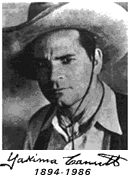 Born
Enos Edward Canutt
in the Snake River Hills, near Colfax, Washington, on November 29,
1894, he earned his
nickname when he was caught fraternizing with several rival rodeo
performers from Yakima,
Washington. His friends never let him forget and the name stuck.
Born
Enos Edward Canutt
in the Snake River Hills, near Colfax, Washington, on November 29,
1894, he earned his
nickname when he was caught fraternizing with several rival rodeo
performers from Yakima,
Washington. His friends never let him forget and the name stuck.
Yak was a major, nationally-reknowned rodeo star during the silent movie era, which led to his starring in several successful series westerns. But it was his talent for handling horses and taking falls that gained him work as a stuntman; a job which he preferred to acting.
At the dawn of the sound era, an illness robbed his voice of its resonance and squelched any possibility of his transistion into the sound era as a leading man. By this time though, he was in big demand as a stuntman, which suited him fine.
In the early 30s, his acting jobs had been reduced to playing mostly
"heavies" in 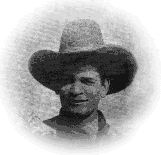 B-westerns and serials for Mascot
and Monogram. But he had found
his niche and became a top stuntman in these same films; which made
them the action
classics they are recognized as today.
B-westerns and serials for Mascot
and Monogram. But he had found
his niche and became a top stuntman in these same films; which made
them the action
classics they are recognized as today.
During this time he worked with a young unknown named John Wayne. Since Yak was an accomplished horseman and a real cowboy, John often sought his advice. Yak taught John the finer points of handling horses and about how real cowboys acted. Duke developed his famous on-screen mannerisms during this period, which were largely patterned after Yak.
The two starred in a series of immensely popular B-westerns known as the 'Lone Star' westerns: from the production unit led by Paul Malvern at Monogram. These were good, albeit formula, westerns that were full of action and very entertaining to watch, even today. Of course, Yakima Canutt coordinated and performed most of the hair-raising stunts that made these pictures so thrilling.
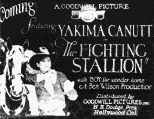 One
of Yak's silent films.
One
of Yak's silent films.
Yak and Duke took great care in choreographing their fight scenes in these films. Yak had previously come up with a method of throwing a screen punch that is today standard practice among stuntpeople. He positioned the action so that when a punch was thrown, it was always thrown towards the camera; which would be shooting over the shoulder of the receiving actor. When filmed from this point of view, the fact that a punch did not really connect was cleverly concealed. With even moderately-accurate timing from the performers, audiences saw what appeared to be real fisticuffs. With the addition of appropriate sound effects, the illusion was complete. The realism of all movie fights was increased dramatically thanks to his innovation.
Nearly every B-western series with a penchant for fast-paced, high-action exploits, such as those starring Gene Autry and Roy Rogers, owed their reputations to the skill of Yakima Canutt. Often, when scripts called for a fight scene or chase, no description or outline was written; only the words "Action by Yakima Canutt" were pencilled-in. This is a testament to the high-regard in which he was held in the industry. His talent for the engineering and precise execution of elaborate stunts made what seemed to be the impossible, possible, and held us to the edges of our seats in the process. You can actually feel your heart in your throat when you see Yak ride a horse off a cliff into a watery chasm! Or when he jumps off horseback onto a runaway wagon. His running mounts were classic: he could jump straight off the ground into the saddle with just a step or two, or even from a second-story balcony. He made our cheers for the hero louder and our sneers at the villian lower. He markedly increased the level of excitement--and hence, our emotional involvement--in the motion picture medium.
The 1939 landmark western "Stagecoach"--John Wayne's proving ground in "A" pictures--was made even more unforgettable by Yakima Canutt. (By the way, for a good look at Yakima Canutt the actor, he has the first line in the movie.) Yak was also there to help Wayne deal with an antagonistic director named John Ford; who nearly caused Duke to walk off the picture, were it not for Yak's diplomacy.
It was also in this film that Yak performed one of his most famous
stunts: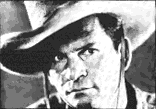 the
daring pass under the moving
stagecoach. Doubling an Indian, he rode his horse up ahead of the
stagecoach, then jumped
over to the lead team, from which he dropped to the ground. Holding
onto the rigging
between them, he drug underneath the speeding horses. After a short
time, he released his
grip and allowed the remainder of the team and the stagecoach to pass
completely over his
body. The scene is as breathtaking today as it must have been when it
was made, over 60
years ago! Fans of the Lone Star westerns recognize this stunt as a
specialty of Yak's; he
did many variations of it in the years before.
the
daring pass under the moving
stagecoach. Doubling an Indian, he rode his horse up ahead of the
stagecoach, then jumped
over to the lead team, from which he dropped to the ground. Holding
onto the rigging
between them, he drug underneath the speeding horses. After a short
time, he released his
grip and allowed the remainder of the team and the stagecoach to pass
completely over his
body. The scene is as breathtaking today as it must have been when it
was made, over 60
years ago! Fans of the Lone Star westerns recognize this stunt as a
specialty of Yak's; he
did many variations of it in the years before.
That same year, Yak could be seen performing stunts in the classic "Gone With The Wind". That's Yak doubling Clark Gable, driving the wagon through the burning streets of Atlanta. Yak, the actor, also shows up in this film; he's the renegade soldier who attacks Vivien Leigh.
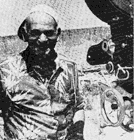 His
masterful second-unit work has given us some of the movies' most
memorable action
sequences. Who can forget the epic chariot race in "Ben Hur"? Or the
spectacular
animal action in the classic "Old Yeller"? Yak's legacy can even be
discovered
in smaller pictures; his fantastic car chase in 1967's "The
Flim-Flam Man" is
widely regarded as one of the screen's all-time best.
His
masterful second-unit work has given us some of the movies' most
memorable action
sequences. Who can forget the epic chariot race in "Ben Hur"? Or the
spectacular
animal action in the classic "Old Yeller"? Yak's legacy can even be
discovered
in smaller pictures; his fantastic car chase in 1967's "The
Flim-Flam Man" is
widely regarded as one of the screen's all-time best.
Over the course of his career, he developed several devices and special rigging that made stunt work more spectacular, while at the same time increasing the margin of safety for the stunt performers. Many of these procedures are standard practice among stuntmen today.
Not one performer was seriously injured on any of Yak's films--an unparalleled record! His lifetime of excellence in the stuntman's art was recognized with the presentation of a special Oscar in 1966; the only such award ever presented for stuntwork, before or since. He was inducted into the National Cowboy Hall of Fame in 1975.
Yakima Canutt died on May 24, 1986.
Click to see Yakima Canutt's filmography.
Favorite Links:
The
Flim-Flam Man Fansite
Drive-In
Theatre Workshop
The
Wesley Trout Shrine
 Page created 3/96,
UPDATED 3/8/00
Page created 3/96,
UPDATED 3/8/00
This site created and written by Tim Reed.
Reference material collected from "Stunt Man-the Autobiography of Yakima Canutt" with Oliver Drake (Walker & Co., 1978); an article by Frank Dolven, which appeared in "Big Reel"; and numerous other sources.